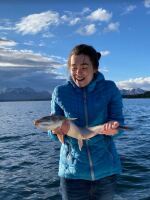Bristol Bay fishermen harvested a record-breaking 60 million sockeye last summer, flooding the market with a surplus of salmon.
Early this month, the U.S. Department of Agriculture agreed to help with the glut by purchasing $119.5 million of canned and fileted Alaska sockeye and Pacific groundfish. It’s a win for the state’s marketing branch, which had some help from Alaska’s congressional delegation. But the purchase won’t totally clear out the storehouses and shelves.
“As far as, you know, fixing the problem of such a giant harvest from last year, it's not going to fix anything,” said Bruce Schactler, the Alaska Seafood Marketing Institute’s global food aid director. “But it's certainly going to help in a big way — in a really big way.”
Schactler said ASMI asked the USDA to buy Alaska seafood for their food assistance programs last fall, when they knew there would be surplus.
“It kind of got stalled, for whatever reason,” he said. “So we asked the three members of our congressional delegation to provide some encouragement to hurry this along. And that was clearly successful.”
Sens. Lisa Murkowski and Dan Sullivan, and Rep. Mary Peltola submitted a joint letter to the USDA at the end of March. They asked the department to commit to buying millions of pounds of Alaska sockeye and pollock. The request included 5 million pounds of frozen sockeye filets, along with hundreds of thousands of canned salmon and 50 million pounds of pollock.
The USDA agreed to buy up to $67.5 million of Alaska sockeye and $52 million of whiting, rockfish and pink shrimp from west coast fisheries, according to Schactler.
The pressure from the delegation helped cut through the competition, he said, since there’s only so many federal dollars to go around.
“The folks up in the Northeast Atlantic, they want to sell fish, and they do, and the catfish guys, and the Gulf shrimp guys and the West Coast groundfish people,” he said. “Then you're also competing with those same dollars with walnuts, pistachios, and fruits and vegetables.”
The federal process of buying and distributing food can be cumbersome. It took eight months for the USDA to agree to make the purchase. And as for when the fish will be distributed, Schactler isn’t sure.
“There's a lot of things that need to happen now,” he said. “They got to decide where they're going to ship it, how much they're going to ship, when they're going to ship. Is it going to be to Omaha in October? Is it going to be Los Angeles in June?”
Still, Schactler said, the announcement will "provide some relief" to the industry just in time for the summer fishing season. The Copper River fishery is gearing up, and fresh sockeye will soon be on the market.
Correction: This story was updated to clarify that according to ASMI, the $52 million in groundfish is from the west coast, not from Alaska, as indicated by Sen. Dan Sullivan in a delegation news release.
Get in touch with the author at izzy@kdlg.org or 907-842-2200.



